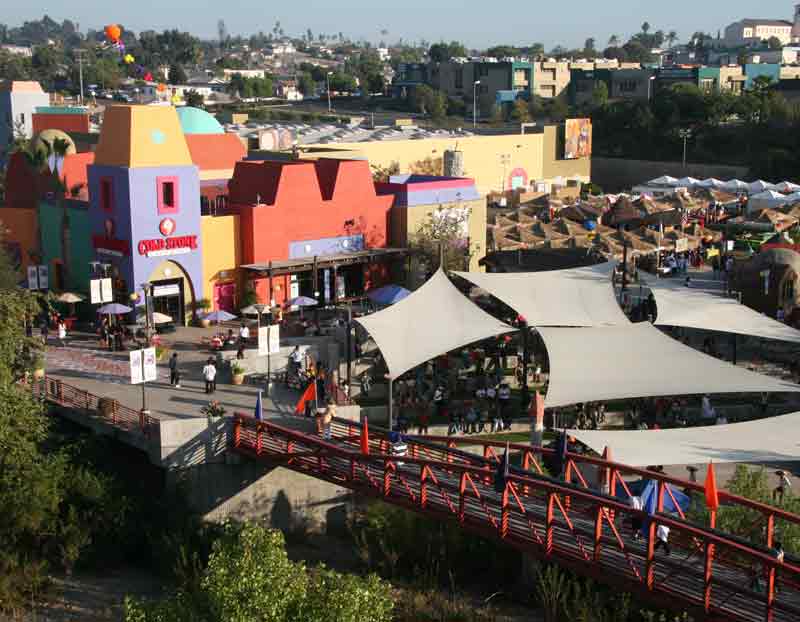In recent years, Californians have been working to rejuvenate and address struggling neighborhoods with statewide efforts to create more opportunities for affordable housing and sustainable communities. The Catalyst Projects for California Sustainable Strategies Pilot Program is the state’s latest endeavor; the program leverages resources to aid projects that exemplify sustainable development principles. With the Catalyst Program, the state has the opportunity to test innovative strategies and revitalize communities experiencing decline. The Diamond Neighborhoods — a diamond-shaped business improvement district in San Diego, California — is one such community that has experienced neglect and underinvestment for several decades. The Catalyst Program is helping transform 60 acres of underutilized, blighted land within this community into a vibrant, mixed-use community.

A photo of Market Creek Plaza, part of the Village of Market Creek development in San Diego, California. Photo credit: JCNI Staff; Photographer: Jean Savage
The Catalyst Program
The Program is tied to two key pieces of state legislation: Proposition 1C, which authorizes the state of California to use funds for new and existing housing programs, and the landmark Senate Bill 375 (SB 375), which aims to reduce greenhouse gas emissions by promoting coordinated regional transportation and housing planning. The program supports the goals and objectives of SB 375 by leveraging public and private financing to support the development of projects that increase housing supply and affordability, encourage multimodal transit options, and achieve energy conservation. In addition to state and local funds, the program will help municipalities compete for funding opportunities that are made available through the Partnership for Sustainable Communities — an interagency partnership among the Departments of Transportation, Housing and Urban Development, and the Environmental Protection Agency. The Partnership among these three Cabinet-level agencies has been created to support healthy, transit-rich, thriving, and affordable neighborhoods for American families.
Local governments in the state were invited to submit applications for new or rehabilitation developments within their jurisdictions to be designated as Catalyst Projects. Of the 25 applications received, 13 communities were selected in August 2010. The successful applicants were chosen based on their ability and commitment to remove barriers to the development of transformative projects, effectively promote the relationship between jobs and housing, and develop a Sustainable Communities Strategy as required by SB 375. Each Catalyst project will receive support from the state, including access to state funding resources, bonus points for specified state funds, technical assistance from teams of state agencies, and other state assistance as deemed appropriate. Five of the thirteen communities, designated as Gold Catalyst projects, are also eligible for additional funding. The Village at Market Creek in San Diego’s Diamond Neighborhoods is one of the five Gold Catalyst projects awarded $1.35 million to aid in the development of a former brownfield site.
The Village at Market Creek
The Village at Market Creek is the result of a resident-led planning process in conjunction with the Jacobs Center for Neighborhood Innovation — a nonprofit foundation, and sister organization to the Jacobs Family Foundation, which helps build strong communities by supporting resident ownership. “What makes our project different — and truly sustainable — is that the work is being planned, implemented and owned by residents who are revitalizing their neighborhoods,” said Jennifer Vanica, president and CEO of the Jacobs Center for Neighborhood Innovation. The Village at Market Creek, centered around a transit hub, is being developed in several phases over a period of 10 to 15 years. When fully completed, the Gold Catalyst-designated project will contain over 1,000 affordable housing units, 645,000 square feet of commercial space, and 400,000 square feet of open space and parks. Over half of the housing units will be affordable to families earning between 30 and 60 percent of area median income. The homes will be located within a quarter mile of medical centers, community centers, and transit facilities. Approximately 5,500 linear feet of wetlands will be restored and a number of sustainable features, such as drought-tolerant landscaping, recycled building materials, and solar power, are included. The Village, which is expected to become a LEED Gold-Certified Neighborhood, incorporates sustainability principles with efficient patterns of infill connected by pedestrian pathways and bikeways to fully redevelop the previously underutilized land.
Conclusion
For several decades, the Diamond Neighborhoods faced economic hardships and neighborhood decline. To reverse disinvestment and spur revitalization, the state of California introduced an innovative program that helps leverage resources to areas most in need. The Catalyst Program has allowed the Diamond Neighborhoods to gain access to finances and technical assistance. With increased funding and community involvement, the heart of the neighborhood — The Village at Market Creek — has helped transform the area from a blighted brownfields site into a vibrant, mixed-use community.
Previous Search Archive
|


